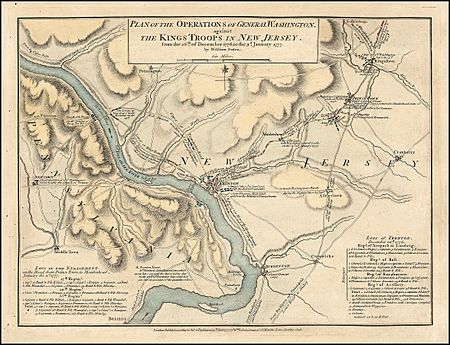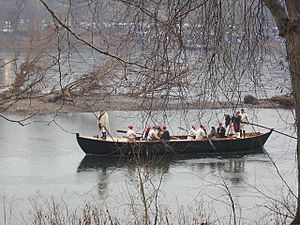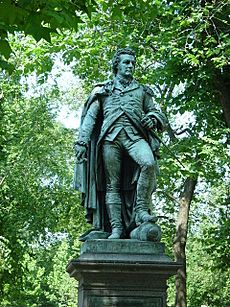George Washington's crossing of the Delaware River facts for kids
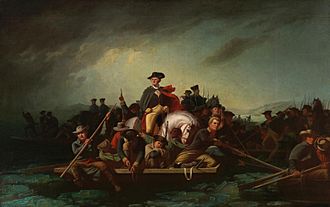
Washington Crossing the Delaware, by George Caleb Bingham, 1856–1871
|
|
| Date | Night of December 25–26, 1776 |
|---|---|
| Location | Present-day Washington's Crossing National Historic Landmark, Pennsylvania and New Jersey |
| Participants | George Washington, Continental Army |
| Outcome | Battle of Trenton |
George Washington's crossing of the Delaware River was a very important event during the American Revolutionary War. It happened on the night of December 25–26, 1776. General George Washington led his Continental Army troops across the icy Delaware River. This was the first step in a surprise attack against Hessian soldiers. Hessians were German soldiers hired by the British.
The attack took place in Trenton, New Jersey, on the morning of December 26. Washington's plan was kept mostly secret. Crossing the river was very difficult and dangerous. Other planned crossings to help the main attack did not happen or failed. But this did not stop Washington. He surprised and defeated the Hessian troops led by Johann Rall in Trenton.
After the battle, Washington's army crossed the river back to Pennsylvania. They brought back prisoners and military supplies they had captured. Washington's army crossed the river a third time at the end of the year. This time, it was even harder because they did not know how thick the ice was. They defeated British soldiers led by Charles Cornwallis at Trenton on January 2, 1777. Then, they defeated his troops again at Princeton on January 3. After these victories, the army moved to their winter camp in Morristown, New Jersey.
The towns of Washington Crossing, Pennsylvania, and Washington Crossing, New Jersey, are named to remember this important event.
Contents
Why the Crossing Was Needed
The year 1776 started well for the Americans. British troops left Boston in March. But the defense of New York City went badly. British General William Howe landed troops on Long Island in August. He pushed Washington's Continental Army out of New York by mid-November. The British captured American troops on Manhattan.
Most British troops went back to New York for the winter. They left Hessian soldiers in New Jersey. These Hessian troops were commanded by Colonel Rall and Colonel Von Donop. They were stationed at small outposts around Trenton. General Howe then sent troops under Charles Cornwallis into New Jersey. Cornwallis chased Washington's army across New Jersey.
Cornwallis set up a line of outposts from New Brunswick to Burlington. This included outposts at Bordentown and Trenton. He then sent his troops to their winter camps. The British were happy to end the fighting season. This was a time for generals to plan and get new supplies for the next spring.
Washington's Army Faces Challenges
Washington's army camped near McConkey's Ferry. This was not far from the crossing site. During their retreat across New Jersey, Washington had lost many soldiers and supplies. Two important parts of his army had not arrived. General Horatio Gates was in the Hudson Valley, and General Charles Lee was in western New Jersey with 2,000 men.
General Gates was delayed by heavy snow. General Lee did not think highly of Washington. He preferred to stay near the British troops. Lee delayed following Washington's repeated orders. On December 12, 1776, British troops captured Lee. This happened while he was writing a letter complaining about Washington. General John Sullivan then took command of Lee's division.
Washington's army was getting smaller. The soldiers also felt discouraged because of the recent defeats. Many soldiers' enlistments were ending at the end of the year. Many wanted to leave the army. Some even left before their time was up.
The American Crisis Inspires Troops
The mood of the American soldiers improved on December 19. A new pamphlet called The American Crisis was published. It was written by Thomas Paine, who also wrote Common Sense.
These are the times that try men's souls; the summer soldier and the sunshine patriot will, in this crisis, shrink from the service of his country; but he that stands it now, deserves the love and thanks of man and woman. Tyranny, like hell, is not easily conquered; yet we have this consolation with us, that the harder the conflict, the more glorious the triumph.
Within a day, General Washington ordered it to be read to all his troops. It encouraged the soldiers and helped them feel better about their difficult situation.
New Soldiers Arrive
On December 20, General Lee's division of 2,000 troops arrived. They were now under General John Sullivan. Later that day, General Gates' division also arrived. Soon after, 1,000 more militiamen from Philadelphia joined Washington. They were led by Colonel John Cadwalader.
With these new soldiers and local volunteers, Washington had about 6,000 men ready for duty. However, many were sent to do other important jobs. Some guarded ferries at Dunk's Ferry. These ferries were important for Washington's plan. Another group protected supplies at Newtown, Pennsylvania. They also guarded the sick and wounded. This left Washington with about 2,400 men ready to cross the river and fight.
The arrival of much-needed blankets on December 24 also helped improve the soldiers' spirits.
Planning the Surprise Attack

General Washington felt encouraged by the arrival of new troops. He began to plan a surprise attack. He sent his assistant, Joseph Reed, to meet with Samuel Griffin. Griffin commanded a local militia near Mount Holly. This militia agreed to create a distraction for Washington. They did this with the Battle of Iron Works Hill the next day. This battle drew the Hessians at Bordentown south. This meant they could not help the Trenton soldiers on December 26.
Washington's final plan involved three crossings. His troops, the largest group, would lead the attack on Trenton. A second group, led by Cadwalader, would cross at Dunk's Ferry. They would create a distraction to the south. A third group, led by Brigadier General James Ewing, would cross at Trenton Ferry. They would hold the bridge over the Assunpink Creek, south of Trenton. This would stop the enemy from escaping that way. Once Trenton was safe, the army would move against British posts in Princeton and New Brunswick. A fourth crossing was planned, but it was canceled.
Preparations for the attack began on December 23. On December 24, the boats used for the crossing were brought from Malta Island. They were hidden near McConkey's Ferry, Washington's crossing site. Security was increased there. A final planning meeting happened that day with all the generals. Washington gave the final orders on December 25.
Boats for the Crossing
Local militiamen and the Pennsylvania Navy helped build boats for the crossing. Captain Daniel Bray, Captain Jacob Gearhart, and Captain Jacob Ten Eyck were chosen by Washington. They were in charge of the boats. They oversaw moving soldiers, horses, and cannons.
Large ferry boats were used to carry wagons. They likely carried horses and cannons too. Many Durham boats were used to carry soldiers. These boats were made to carry heavy loads from iron works. They had high sides and a shallow bottom. Poles, not oars, could be used to push them across the river.
Experienced boatmen operated the boats. The most famous were men from John Glover's Marblehead Regiment. These were skilled sailors from Marblehead, Massachusetts. They were joined by sailors, dockworkers, and boat builders from Philadelphia. Local ferry operators who knew the river well also helped.
The Dangerous Crossing
On the morning of December 25, Washington ordered his army to prepare three days' worth of food. Every soldier also had to have fresh flints for their muskets. At 4:00 p.m., all soldiers, including officers and musicians, received ammunition. They were told it was a secret mission. They would march in lines of eight men to McConkey's Ferry. They had to be as quiet as possible. Washington's plan was to start crossing as soon as it was dark. But most troops did not reach the crossing point until about 6:00 p.m. The weather got worse, changing from drizzle to rain, then to sleet and snow.
Henry Knox, Washington's main artillery officer, was in charge of the crossing details. He had to move many soldiers (most could not swim), horses, and eighteen cannons across the river. Knox wrote that the crossing was done "with almost infinite difficulty." The biggest danger was floating ice in the river. One person said that if it were not for "the loud voice of Colonel Knox," the whole operation might have failed.
Washington was one of the first to cross. He went with Virginia troops led by General Adam Stephen. These troops formed a line of armed guards around the landing area in New Jersey. They had strict orders that no one could pass through. The secret password was "Victory or Death." The rest of the army crossed without much trouble.
The amount of ice on the river stopped the cannons from finishing the crossing until 3:00 a.m. on December 26. The troops were ready to march around 4:00 a.m. This was about four hours behind schedule.

The two other planned crossings did not go well. The bad weather and ice on the river stopped General Ewing from even trying to cross. Colonel Cadwalader crossed many of his men to New Jersey. But when he could not get his cannons across, he called his men back. When he heard about Washington's victory, he crossed his men over again. But he retreated when he found out Washington had not stayed in New Jersey.
The Attack on Trenton
On the morning of December 26, Washington's army was ready. He split it into two groups. One group was led by himself and General Greene. The second was led by General Sullivan. Sullivan's group took River Road from Bear Tavern to Trenton. Washington's group followed Pennington Road. This road was a few miles inland from the river. Only 3 Americans were killed and 6 wounded. The Hessians had 22 killed and 83 wounded. The Americans captured about 900 prisoners. They also took muskets, gunpowder, cannons, and the Hessians' food.
Back to Pennsylvania
After the battle, Washington had to cross the river a second time. This was difficult because the troops had to move the prisoners across the river while guarding them.
The victory greatly improved the soldiers' spirits. They celebrated the win. Washington proved he was a strong leader. And the American Congress felt renewed hope for the war.
The Third Crossing
In a war meeting on December 27, Washington learned that all British and Hessian forces had moved north to Princeton. In a letter, Cadwalader suggested that the British could be completely driven out of the area. After much talk, the leaders decided to try to remove the British. They planned a third crossing for December 29.
Because so many soldiers were involved, eight crossing points were used. It had become very cold. The ice was 2 to 3 inches thick at some crossing points. These areas were strong enough for soldiers to walk across the ice. At other crossings, the conditions were too bad, and attempts were stopped for the day. It was New Year's Eve before the entire army and all its equipment were back in New Jersey.
Washington then took a strong position just south of the Assunpink Creek, across from Trenton. From this spot, he defeated an attack on January 2, 1777. The next day, he won a major victory at Princeton. In the following days, the British moved back to New Brunswick. The Continental Army then went to their winter camp in Morristown, New Jersey.
What We Remember Today
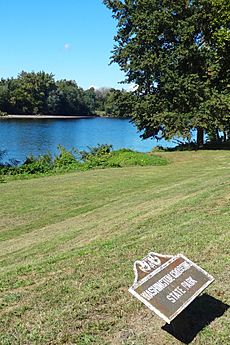
At the time of the crossing, Washington's army included people who became very important in the early days of the United States. These included future President James Monroe and future Chief Justice of the United States John Marshall. Also, Alexander Hamilton, who became the first Secretary of the Treasury, and Arthur St. Clair, who later led the Continental Congress.
Both sides of the Delaware River where the crossing happened are now preserved. This area is called Washington's Crossing National Historic Landmark. Washington Crossing Historic Park in Washington Crossing, Pennsylvania, protects the area in Pennsylvania. Washington Crossing State Park in Washington Crossing, New Jersey protects the area in New Jersey. The Washington Crossing Bridge connects the two parks.
In 1851, the artist Emmanuel Leutze painted Washington Crossing the Delaware. This famous painting shows an inspiring picture of the event. The crossing has also been shown in movies. A well-known recent one is The Crossing, a 2000 TV movie starring Jeff Daniels as George Washington.
See also
 In Spanish: Cruce de Washington del río Delaware para niños
In Spanish: Cruce de Washington del río Delaware para niños


